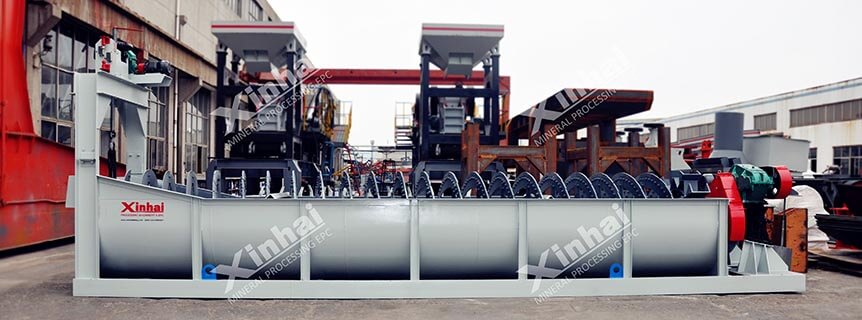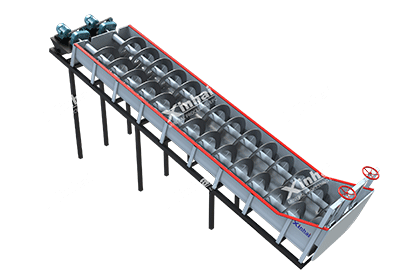Spiral Classifier's Common Failures and Solutions
 Essow
Essow
 Nov 13, 2020
Nov 13, 2020
 5767
5767
If you want to know more details about equipment, solutions, etc, please click the button below for free consultation, or leave your requirements!

The stable operation of equipment is an important way to ensure the economic benefits of the mineral processing plant.
In ore dressing production, the spiral classifier is mainly used for one stage grinding and grading, and together with the ball mill to form a closed-circuit grinding.
In the daily work, if the spiral classifier fails, it will not only affect the grinding production, but also affect the normal operation of the entire beneficiation process.
Therefore, it is very important to clarify the cause of the failure of the spiral classifier and reduce the failure rate. This article will start with the three common failures in the daily operation of the spiral classifier, and then analyze the causes and solutions.
01Failure #1 The main shaft of the spiral classifier is broken
BackDue to the long-term harsh working environment, the main shaft (hollow shaft) of the spiral classifier is prone to damage or breakage. This problem is not only a common failure of the spiral classifier, but also a major problem that is difficult to solve, which has a great impact on the normal operation of the spiral classifier.
Solutions:
When the main shaft of the spiral classifier is damaged or broken, we can choose to repair or replace the main shaft.
Pay attention to the following points when repairing the main shaft:
The most important thing is to ensure the coaxiality of the spindle and the strength at the port.
Ensure that the overall length of the main shaft remains unchanged.
When welding and fixing, keep the relative data of each point equal and the axis position the same.
When welding, pay attention to preventing the deformation of the shaft welding to ensure the welding quality. Polish after welding to keep the height of the weld seam not is greater than the surface of the main shaft.
02Failure #2 The blades in the lower part of the main shaft of the spiral classifier (below the feed port) are severely worn
BackWhen entering the classifier from the feed port, the slurry sinks downward with a certain impact force and inertia, and the blade spacing on the main shaft of the classifier (below the feed port) is wide, and a large part of the slurry cannot be fed to the large and small blades to be classified, but directly rush to the main shaft, which increases the main shaft wear in this area.
In addition, the unclassified ore pulp that directly impacts the main shaft settles into the settlement area, increasing the amount of deposits in the settlement area. When the blades rotate to this area, the increased friction of the blades causes faster wear and shortens the service cycle.
Solutions:
We can shorten the distance between the blades on the main shaft of the classifier and increase the lead in a reasonable range, thereby increasing the density of the spiral classifier, so that the slurry can be fed to the spiral blades more effectively, and the deposit area of the mineral particles in the settlement area can be reduced. Doing so, we can make the slurry to be agitated uniformly, classified fully, thus improving classification efficiency, and achieving the purpose of protecting the main shaft.
03Failure #3 Failure of the lower support bearing of the spiral classifier
BackThe lower support of the spiral classifier is composed of three parts: connecting part, supporting part and sealing part.
When working normally, the amount of returned sand will cause a large axial force on the blade, and the spiral classifier itself is installed obliquely, and its own weight is very large, so a certain axial force will also be generated.
These axial forces are theoretically borne by the upper thrust ball bearing. In fact, with the wear of the upper support and the influence of errors in assembly, the operating axial force becomes larger and larger, causing the hollow shaft to move down, which will cause large thrust force to the lower support, making the bearing extremely easy to overload and heat up and get stuck.
At the same time, due to the serious friction and heating of the filler, the heat is not easy to dissipate, and it will also cause the bearing to become stuck due to thermal expansion.
Solutions:
Under the premise of keeping the suspension form and flange connection form unchanged, and the outer dimension unchanged, we can install the bearing in the front section of the lower support, leaving the dead zone of sand accumulation, and immersing under the movable liquid surface to facilitate the heat dissipation of the bearing.
04To Wrap Up
BackThe above are the three common failures and solutions of the spiral classifier. To make equipment operate stably and efficiently, in addition to selecting equipment types that meet the mineral processing process, daily maintenance are more important.
Therefore, we recommend that all mine owners consult with equipment manufacturers with overall mineral processing plant qualifications when choosing a spiral classifier, and choose equipment suitable for their own process flow to further improve the efficiency and economic benefits of the mineral processing plant.
If you have any questions about the common faults and solutions of the spiral classifier, please leave a message to communicate with us or consult our online customer service, we will contact you as soon as possible.
 +86 183 3575 8886
+86 183 3575 8886 pinklaurabao@gmail.com
pinklaurabao@gmail.com




 Message
Message Chat Now
Chat Now

















